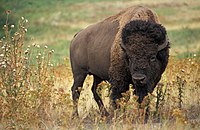
Photo from wikipedia
Little is known about the correlations between the genetic susceptibility/resistance to Mycobacterium avium subsp. paratuberculosis (Map) infection and the estimated breeding values for type, production and functional traits. Previously, we… Click to show full abstract
Little is known about the correlations between the genetic susceptibility/resistance to Mycobacterium avium subsp. paratuberculosis (Map) infection and the estimated breeding values for type, production and functional traits. Previously, we identified 70 combinations of five single nucleotide polymorphisms (SNPs) in four bovine innate immune genes (SLC11A1, SP110, TLR2, CD209) that are associated with the genetic risk of paratuberculosis (PTB) or Johne's disease progression, which can be graded as low (LOWIN), latent (LATIN), or patent (PATIN) risk. Other possible combinations of these 5 SNPs were grouped in the average group (AVERIN). In the current study, differences in estimated breeding values (EBVs) for several traits were analyzed using linear models in a large cohort of Holstein cows (N = 15656) genotyped across Spain in 2016 or 2017. After the assignment of each genotyped cow to a risk group, cows within the PATIN risk group (N = 1448) had a superior combined genetic index (2797.57), type genetic index (524.62), milk yield (653.92 kg), protein yield (21.77 kg), fat yield (24.82 kg) and economic merit index (125 Euros) compared with the other three risk groups. Statistically significant differences in the longevity scores between the cows that were included in the PATIN risk group (108.85) and the LOWIN (107.82) and AVERIN (107.92) groups were also observed. The associations between the genetic risk groups and PTB diagnostic results were validated in a population of 99 cows from a Spanish farm with a high prevalence of PTB. Significant differences in ELISA readings between the PATIN (65.49 %) and the AVERIN (15.97 %), LATIN (2.11 %), and LOWIN (3.27 %) groups were observed. In addition, significant differences in Map DNA copies/gram of feces were observed between the PATIN and the other three risk groups. These results together with the substantial economic impact of PTB in dairy cattle support the selection of the animals with less susceptibility to PTB in the Spanish breeding program.
Journal Title: Heliyon
Year Published: 2020
Link to full text (if available)
Share on Social Media: Sign Up to like & get
recommendations!